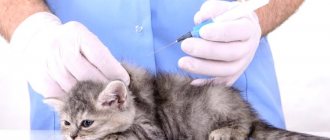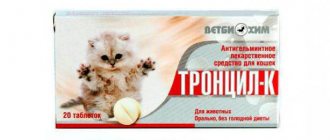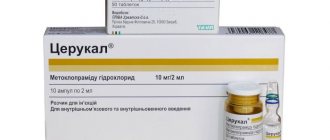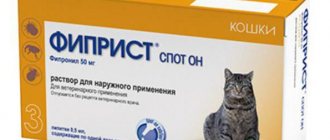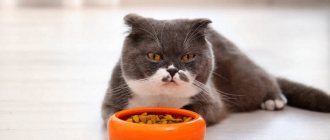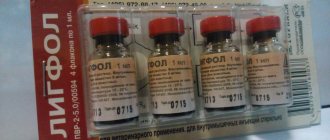Ready-made food for cats with diabetes
It is very convenient to feed mustachioed pets with ready-made industrially produced diabetic food - dry and wet. It is best to give elderly cats wet food and canned food - they are better digested and absorbed by an already middle-aged body. The dosage and frequency of feeding is indicated on each package or can. All ready-made foods for diabetic cats contain a large amount of protein and practically no carbohydrates.
- Young Again Zero Mature Health Cat Food ($32/1.8 kg dry);
- Young Again 50/22 Cat Food ($44/3.6 kg dry);
- Purina Veterinary Diet DM Dietetic Management (about RUB 1,200/1.5 kg dry);
- Purina Pro Plan (about 1,200 rub./1.5 kg dry, 130 rub./195 g dry food, up to 100 rub./85 g wet food);
- Vet Life Cat Diabetic (about RUB 1,900/1.2 kg);
- Prescription Diet Feline m/d (about 1500 rub./1.5 kg, 140 rub./156 g cons.);
- Royal Canin Diabetic DS46 (RUB 1,300/1.5 kg);
- Royal Canin Diabetic (RUB 75/100 g wet food).
Signs of diabetes in cats
Tests will help make an accurate diagnosis
As a rule, when owners seek advice from a veterinarian regarding suspicions that their pet has diabetes, it is very late. And, all because the signs and symptoms of the disease are often simply ignored by the owners or they simply do not pay attention to them. However, if you notice that:
- The animal’s body weight has increased sharply or, conversely, the cat has lost a lot of weight in a short period of time with a constant diet,
- The animal drinks liquids often and in large quantities,
- The cat began to urinate more often and more,
- The pet suffers from lack of appetite (why the cat doesn’t eat - this is described in detail in one of our publications) or excessive appetite,
- The pet's gait has changed - it has become shaky and uncertain, the hind legs look weaker, and the cat steps not on the toes of the limbs, but on the entire foot,
- Scratches and wounds appeared on the animal’s skin, which took a long time to heal,
- The smell of acetone is felt from the pet's mouth,
- The cat looks sloppy and untidy, does not take care of its fur...
If you notice one or more symptoms in your pet, do not put off visiting the veterinarian. The sooner diabetes is detected and a correct diagnosis is made, the sooner treatment can begin and the greater the likelihood of saving the life and health of the animal.
Diabetes in a cat: symptoms, treatment
Diabetes mellitus in cats is an endocrine disease associated with insufficient production of insulin by the pancreas, which has become more and more common in recent years. Statistically, it occurs more often in older cats and in overweight animals. Moreover, cats get diabetes more often than cats.
The exact causes of diabetes mellitus are unknown; predisposing factors are:
- obesity, - treatment with hormones, - pancreatic diseases, - the period of the first 1-2 months after estrus, - pregnancy, - hormonal disorders.
Diabetes: symptoms, diagnosis.
The diagnosis is quite simple: a number of clinical signs are most often complaints of increased appetite and at the same time loss of body weight, the animal drinks a lot and urinates a lot. A fasting blood test is taken - in diabetes, it shows a high level of glucose, and glucose or even ketones are also released in the urine. Diagnosing diabetes mellitus only on the basis of a blood test is incorrect, because in cats, blood glucose can increase from stress, and coming to the clinic and all sorts of unpleasant manipulations of taking blood is quite stressful. Even if the animal behaves calmly. Therefore, if your blood glucose is high, be sure to take a urine test!
Normally, the kidneys do not pass glucose from the blood into the urine, but when the level of glucose in the blood is very high, the kidneys cannot cope and the glucose begins to be excreted in the urine.
Ultrasound for diabetes in a cat. Fructosamine
The doctor will also suggest doing an ultrasound of the abdominal cavity. And in cats they suggest taking an additional test for fructosamine - this is a protein that transports glucose. Fructosamine allows us to distinguish a true increase in glucose from a stress one. It circulates in the blood for two to three weeks and its amount increases gradually, following the gradual increase in blood glucose levels in the case of diabetes. Therefore, in diabetes, fructosamine will be increased. Under stress, this indicator remains within the normal range.
After the diagnosis is made, the animal is prescribed treatment. Unlike humans, oral hypoglycemic drugs are almost never prescribed to cats for a number of reasons. Cats are given subcutaneous insulin injections - this is a simple procedure that any owner can do. Usually 2 injections are given per day (morning and evening) and blood glucose is measured periodically.
Glucose control in diabetic cats
How is glucose controlled? Glucose is measured strictly on an empty stomach, because after eating there is a physiological increase in glucose. You can take measurements at the clinic or yourself. Use a regular glucometer and test strips.
They only pierce with an injection needle - the special “pen” that people use is not suitable for the stomach at all. A drop of blood is usually taken from the ear. The doctor usually shows you how to do this at your appointment. There is a vessel along the edge of the ear (it is clearly visible if you illuminate the ear with a flashlight on your phone), wipe the site of the future injection with alcohol, and when the alcohol dries, pierce it with a needle and press lightly. Apply the test strip to the resulting drop. The result will be displayed on the scoreboard. Press the injection site with a sterile napkin or cotton wool until the bleeding stops.
Glucose diary for diabetes
You should keep a glucose diary and carefully record all data. This will help the doctor assess the dynamics of the disease and adjust the insulin dose if necessary.
Control days are usually carried out every 3 weeks.
Treatment of diabetes mellitus in cats
Diabetes in cats is a disease that can and should be treated, but this requires the patience and perseverance of the owner. In some cases, insulin injections will be required, but in mild forms, dietary adjustments and weight normalization are sufficient.
First of all, when treating, doctors try to identify and eliminate the provoking factor in the development of the disease. Let us highlight the main objectives of treatment:
- elimination of clinical symptoms;
- maintaining normal weight;
- prevention of complications;
- improving quality of life.
Insulin therapy
To compensate for insulin deficiency, it is recommended to administer the hormone externally. The dosage may vary for each animal. To determine the body's response, a curve is constructed based on glucose levels. Insulin can differ in the duration of its action; for example, for type 1 diabetes, short-acting insulin is prescribed, and for type 2, medium- or even long-acting insulin is prescribed.
When diabetic ketoacidosis develops, insulin is administered every two hours while blood sugar levels are monitored. In this situation, intensive therapy is indicated.
Some cat owners are misinformed about insulin and are afraid to use it, but there is nothing wrong with that, the hormone will help prolong the life of your pet. It is usually recommended to admit the animal to the clinic for several days to determine the insulin dosage. And then after some time appear for correction.
Important! Low glucose levels are worse than hyperglycemia. If elevated sugar levels gradually affect the body, then hypoglycemia can quickly lead to fatal consequences
An overdose of insulin can cause your blood sugar levels to plummet. The following symptoms may indicate this:
- weakness and lethargy;
- convulsions;
- shiver;
- nervous tic;
- unsteady gait;
- loss of consciousness.
In case of hypoglycemia, you should urgently give the animal sugar syrup or honey. This critical condition may be the result of taking too much insulin, increasing activity, or reducing food intake.
Hypoglycemic tablets are not used for diabetes in cats. If the pancreas does not work normally, then these pills will not help, and if at least some part of the organ still performs its function, then the drugs make it work for wear and tear. As a result, the animal’s condition worsens significantly, and the period of remission is delayed.
Feeding
Depending on the type of insulin and the characteristics of the animal’s condition, they can either be fed frequently in small portions or provided with constant access to food. It is important to ensure a slow release of glucose into the blood.
Signs of diabetes in cats
Every owner, especially if his pet is at risk, should closely monitor him and consult a doctor in a timely manner. Diabetes mellitus in cats is indicated by the following symptoms.
Frequent urination
With diabetes, a cat begins to visit the toilet more often, since the increase in blood glucose levels stimulates the production of urine in the same way as the consumption of salty foods.
In this case, urination does not cause any unpleasant sensations to the animal, as, for example, with urolithiasis, and therefore cat owners often do not pay attention to this symptom of diabetes and do not begin treatment.
Increased thirst
Naturally, since a cat loses a lot of fluid, it has a strong desire to replenish it. Animals begin to drink more, but if their diet includes predominantly wet food, this is not always noticed in time.
Increased appetite
Diabetic cats do not get enough energy because the lack of insulin prevents them from processing glucose. Of course, the animal begins to ask for more and more food in the hope of finally replenishing its strength.
Weight loss
Even though a cat with diabetes eats and drinks more, she begins to lose weight sharply. And the reason for this is also quite simple: not receiving the necessary energy due to a failure in the absorption of glucose, the body begins to use up fat reserves.
At the same time, the concentration of free fatty acids in the blood increases, and fatty liver degeneration may develop. In advanced cases, the animal can reach complete exhaustion.
Deterioration in appearance
Diabetes mellitus in cats seriously disrupts the metabolism and functioning of the entire body, and therefore ulcers may appear on the cat’s skin, the coat becomes brittle and thin, and loses its shine. In general, when the process goes far enough, the sick cat looks simply terrible.
Weakness in the limbs
About 10% of cats with diabetes have what is called “diabetic neuropathy,” which involves weakness in the hind legs. The animal cannot jump normally and when walking tries to transfer weight to the hock joint, and not to the paw, which is why a peculiar shuffling gait is formed.
Behavioral disorders
As we know, constant anxiety and poor health can provoke a cat to behave badly. Any unexpected changes - increased aggression, toileting in the wrong places - can be signs of any disease, including diabetes.
Drowsiness
Of course, cats love to sleep, but everything has its limits. With diabetes, the animal constantly experiences a lack of energy and constant weakness. Therefore, if a pet stops playing and communicating with its owners, and only sleeps, then you should be wary.
"Fruity" breath
Don't be overjoyed that your cat smells like she just brushed her teeth with fruity mint toothpaste. If we collect all the signs of diabetes in cats, then the sweet smell from the mouth is one of the most common and characteristic.
General characteristics
Glucose injection (Glucosi Solutio proinjectionibus) is a clear or pale yellow liquid that is placed in a glass vial or bottle. To ensure the tightness of the contents, a rubber stopper is used, which is reinforced with a metal cap. The bottle is accompanied by instructions from the manufacturer, which describe in detail its contents, method of use, expiration dates and GOSTs. The bottle with liquid is stored at above-zero temperatures up to 25C in a dark place, protected from excess moisture. Shelf life – 2 years.
The active ingredient of the drug is crystalline medical or hydrated glucose. Auxiliary elements are sodium chloride, water for injection.
They produce 5%, 10, 25 and 40% medicinal products, in which the active substance content is 5, 10, 25 and 40 g per 100 ml, respectively.
The market offers a wide variety of Russian and foreign-made drugs. The drug from the Voronezh pharmacological organization is quite popular. The developer produces an injection solution with different percentages of the active substance and varying volumes (from 10 to 500 ml). It can be used in the treatment of cats, dogs and other domestic animals, as well as large and small livestock.
Important! Before using the drug, consultation with a specialist is necessary. The description below is for informational purposes only and cannot be used for independent prescription and dosage determination.
Hypoglycemia in cats causes, diagnosis and treatment
The manifestation of the above symptoms in a cat is a reason to contact a veterinarian. Based on laboratory tests and medical history, the doctor will be able to make an accurate diagnosis and develop a subsequent treatment plan.
The main indicator for diagnosis is the level of glucose in the blood. But in some cases, disorders and hyperglycemia are observed in stressful conditions in the animal (going to the clinic, traveling in transport, being in a carrier).
To confirm the diagnosis, a urine test for sugar content is performed.
The normal level of glucose in the blood of cats should not be more than 6.0 mmol/l. It is necessary to check the sugar level in the bloodstream up to 5 times a day using a special device to obtain an adequate clinical picture. A glucometer can be used at home to measure the amount of glucose in the blood.
In domestic animals, blood for glucose testing is taken from vessels located on the earlobes.
To exclude concomitant diseases, a general and biochemical blood test, urinalysis, and ultrasound examination of the abdominal organs are required. If necessary, additional studies are carried out: blood tests for hormones, CT, MRI and others.
It is impossible to make a correct diagnosis based only on clinical signs with such a complex disease. Clinical and laboratory methods for examining the pet’s blood and urine come to the rescue.
When analyzing biological fluids, one of the indicators of the disease is excess glucose levels in the blood and the presence of sugar in the urine.
In addition to determining the glucose concentration, a general blood test, insulin determination, and acid-base balance are performed
It is important for the owner to know that all tests must be taken only on an empty stomach.
The veterinarian will also instruct you to determine the amount of water your pet is consuming. In order to establish the pathology of the pancreas, an ultrasound examination is performed. For a differentiated diagnosis, an examination of the heart, liver, and digestive organs is performed.
To confirm the diagnosis, signs alone are not enough, since they can also be symptoms of other diseases. A set of examinations is required: general clinical and biochemical blood and urine tests (taken in the morning on an empty stomach); to determine related problems, tests for hormones and acid-base balance, serial glucose measurements, assessment of the amount of fluid intake and urine output, x-rays, ultrasound, and ECG may be needed.
Determining blood sugar using a glucometer
*Add. expenses are paid. materials: no
Add. Ambulatory fee is paid. reception: no
Why do you need to measure blood sugar? Changes in blood sugar levels can be a symptom of diseases that can lead to seizures, shock, or coma. Blood sugar levels can be either high or low. Let's discuss both pathologies.
DETERMINING BLOOD SUGAR USING A GLUCOMETTER
Why do you need to measure blood sugar?
Changes in blood sugar levels can be a symptom of diseases that can lead to seizures, shock, or coma. Blood sugar levels can be either high or low. Let's discuss both pathologies.
What disease causes high blood sugar levels?
Diabetes mellitus (diabetes mellitus) is a chronic endocrine metabolic disease caused by an absolute or relative deficiency of the hormone insulin. The disease develops as a result of the combined influence of various factors, and is characterized by metabolic disorders with its most constant manifestation - hyperglycemia (increased sugar), the development of damage to blood vessels, nerves, various organs and tissues. A demonstrative and obligatory manifestation of the disease is a violation of carbohydrate metabolism with a progressive increase in the level of glucose in the blood and its excretion in the urine. Significant losses of sugar in the urine cause persistent osmotic diuresis (diabetes) and developing dehydration and potassium loss.
Which animals are susceptible to diabetes and how does this disease manifest?
Diabetes mellitus in dogs occurs in 95% of cases in unsterilized female dogs aged 7-8 years and older. In dogs, diabetes mellitus appears no earlier than 5 years of age, in cats - at 9-11 years of age, provided they are fed natural products. In castrated cats and female cats, diabetes may appear later, in non-castrated cats - earlier, at 5 - 6 years. In some cats, for some reason specifically cats, diabetes mellitus can manifest itself much earlier than the specified period. As a rule, these cats were smaller in size than the average animals of this species group. The exact cause of the disease has not been established to date; hereditary predisposition, hormonal disorders, and severe infectious and systemic diseases are considered as predisposing factors. The main clinical signs to suspect diabetes mellitus in dogs are: increased thirst and frequent excessive urination (polyuria and polydipsia), lethargy, and thinness.
How to diagnose diabetes?
The diagnosis is made after measuring blood glucose levels. When the level of glucose in venous blood is above 11 mmol/l, a diagnosis of diabetes mellitus is made.
How and from what place is blood taken from cats and dogs for sugar?
Blood for biochemical testing in animals is taken from a vein. When determining sugar using test strips, blood is taken by puncturing the blood vessels of the tips of the ears; it is possible to take blood from the crumbs of the fingers.
How often is it recommended to check blood sugar if an animal has diabetes?
In laboratory conditions, you can take blood from an animal every 2 to 3 hours or even more often. If the diagnosis is confirmed, then it is necessary to display the so-called insulin curve 9; in this case, blood is taken up to 10-15 times during the day with an interval of at least an hour. This is necessary to prescribe adequate treatment. But we must take into account that animals are mainly treated on an outpatient basis, which means that determination of blood sugar must be carried out by their owners, who categorically do not want to do this, in most cases. Therefore, most often, primary studies are carried out to confirm the diagnosis - diabetes mellitus or that the animal has high blood sugar. While the animal is slowly recovering from illness, the owners can still go to the laboratory with the animal or call laboratory doctors to the house in order to determine blood sugar. But as soon as the animal’s condition improves significantly, it is very problematic to convince the owners to go to the laboratory and donate blood for sugar again.
How are insulin doses calculated for animals?
Insulin requirements depend on diet, general condition and treatment received. According to the rules, insulin dosage is selected based on graphs of changes in blood glucose levels, which are compiled by measuring sugar every 1 to 2 hours. The reduction in blood sugar levels should be brought to a level of 5.5 -10 mmol/l. The primary dose is calculated at the rate of 0.5 - 1 unit. per 1 kg of body weight, the dose is gradually selected until a visible improvement in the animal’s condition is obtained.
What insulins are used in the treatment of diabetes mellitus in animals?
Preparations of monocomponent porcine insulin-zinc suspension of medium duration of action can be used to treat sick animals. Even with long-term use, it does not cause the appearance of anti-insulin antibodies in the blood. There is a special canine and feline insulin - CANINSULIN, which has proven itself in the treatment of diabetes mellitus.
What complications of diabetes mellitus occur in animals?
Of course, animals suffering from diabetes may experience various complications. In cats, and especially dogs, cataracts are often observed, accompanied by progressive clouding of the lens. Diabetic retinopathy occurs much less frequently in dogs than in humans. Cats often have trophic skin lesions, which are localized on the paws, tips of the ears, muzzle, and much less often on the body. Trophic skin lesions also occur in dogs, especially in advanced cases of diabetes, and they are also localized in the limbs, face, and tail.
What are the reasons for unsuccessful treatment of diabetes?
Unfortunately, a huge number of animals die due to improper and inadequate treatment of this disease. In our opinion, the reasons for this are:
What myths about diabetes in animals prevent effective treatment?
Today, regarding the treatment of diabetes in dogs, there are a huge number of MYTHS that not only interfere with the effective and safe treatment of diabetes, but in many cases simply destroy the animals.
Minimum restrictions and maximum freedom - this is the motto of modern patients with diabetes.
How to feed an animal with diabetes?
What is hypoglycemia?
Hypoglycemia is a decrease in blood sugar levels. Hypoglycemia itself is not a disease; it only serves as an expression of disturbances in the organs and systems responsible for metabolism and regulatory processes in the body.
What are the causes of hypoglycemia?
Which animals are more sensitive to hypoglycemia?
Puppies and kittens under the age of two weeks, as well as dwarf dog breeds, are especially sensitive to a lack of glucose.
How is hypoglycemia diagnosed?
Hypoglycemia is diagnosed based on clinical symptoms and blood test results. For this, a special device is used - a glucometer, which allows the doctor to accurately and quickly determine the concentration of glucose in the patient’s blood. The normal glucose level for an animal is in the range of at least 3.4 mmol/l. A decrease in blood glucose levels to 1.3 mmol/l is accompanied by convulsions; with a further decrease, hypoglycemic coma develops and the animal may die.
How does hypoglycemia manifest?
Hypoglycemia is accompanied by loss of strength, tremor, nervousness, polyphagia, tachycardia, ataxia, muscle fasciculation (impaired coordination of muscle contractions, incoordination, visual impairment, generalized seizures, nervous disorders). If your pet exhibits the above symptoms, you should immediately show it to a doctor. When making a diagnosis in all cases, the following factors must be taken into account: age of first manifestation, type of hypoglycemic state, causes of the disease (stress, hunger or physical activity).
How to treat hypoglycemia?
Treatment consists of replenishing glucose deficiency, and an important aspect is to find out the reasons that caused the drop in sugar. It is imperative to conduct a full examination of the patient, which includes an ultrasound examination of the abdominal organs, taking biochemical and clinical blood tests, excluding viral infections, etc. Only after correct and timely diagnosis can one judge the reasons that caused the drop in sugar in the animal and prescribe the correct treatment.
How common is diabetes in cats?
Diabetes mellitus is one of the most common endocrine diseases in cats. According to some estimates, one in four hundred cats suffers from this disease.
- The first clinical signs most often begin to appear at 5-6 years of age or in old age.
- Males are more prone to the disease than cats.
- The exact figures for the dynamics of the manifestation of diabetes mellitus in these animals are unknown. However, the number of affected cats is growing at an alarming rate every year due to a massive increase in the number of overweight and obese pet cats.
It is important to note that a cat weighing 1.5 kg more than its ideal weight may already be considered obese. This means that the average domestic cat that weighs 6 kg or more is at risk for developing type II diabetes.
Please note that we are not talking about giant breeds of cats, such as the Maine Coon. For such animal breeds the numbers should be increased.
Symptoms of diabetes in cats
Clinical signs largely depend on the type of disease. So, with an insulin-dependent form, the owner can observe the following symptoms in the pet:
- Increased thirst . The clinical sign is caused by a high concentration of glucose in the blood, for the breakdown of which there is not enough insulin. The body's excretory system cannot cope with the load, sugar appears in the urine, and its volume increases. The process is accompanied by dehydration and increased thirst of the sick animal.
- Polyuria. Frequent urination is painless.
- Change in appetite. In this case, both an increase and a decrease in appetite is observed.
- Increased body weight.
- The fur is dull, the pet constantly sheds, and looks sloppy.
- Digestive disorders: vomiting, diarrhea.
- Tachycardia. The heart rate increases sharply.
- Weakness, lethargy of the animal.
- Shaky and uncertain gait.
- As intoxication develops, the owner notes the most characteristic sign of the disease – the strong smell of acetone from the cat. The animal's breath can smell, as can urine and skin.
- In advanced cases, convulsions, fainting, and loss of consciousness of the animal are possible.
A) Obesity. B) Diabetic neuropathy.
With the development of the second type of disease, the following clinical manifestations are observed in a sick animal:
- Increased appetite.
- Rapid weight gain, obesity.
- Polydipsia. The animal constantly drinks water.
- Frequent, painless urination.
- The pet's condition is usually satisfactory.
Unlike type 1 diabetes, the non-insulin-dependent form is not accompanied by the smell of acetone from the animal.
Hyperglycemia and low blood sugar
A large amount of glucose in the blood of an animal is scientifically called hyperglycemia. This condition can be provoked by various reasons, and therefore material for research must be taken repeatedly during the same time of day under the same conditions.
shutterstock
Elevated glucose levels are easy to detect. The cat begins to drink more water and often approaches the bowl. In addition, she may wet herself before reaching the tray and without even realizing the reasons for the puddle. Against the background of hyperglycemia and the formation of diabetes mellitus, the cat becomes lethargic, loses appetite, and has impaired coordination and gait.
Insufficient glucose is hypoglycemia. This condition is even worse than the first. A sharp jump in the level can cause pre-fainting, fainting, and coma in the animal.
The cat's consciousness and perception of the surrounding world are disrupted. The animal may vomit, while the cat itself feels constant hunger. Also, such disturbances in sugar levels lead to depressive disorders, anorexia, and frequent urination.
Reasons for violation
There are many reasons for high blood sugar. Among them the most common :
- Treatment of a cat with drugs with a high content of hormones , while taking them the weight of the animal has increased. The thing is that with sudden weight gain, metabolic processes in the cat’s body slow down.
- Diseases of the endocrine system . If there are problems with the thyroid gland, it is enlarged and inflamed, then when it deviates from the norm, diabetes occurs.
- The cat suffers from pancreatitis or has irritations of the central nervous system. In some cases, these diseases show up on a blood test.
- Stress . Due to strong emotions experienced, a cat’s blood sugar can jump sharply and fall just as sharply. This increase in glucose does not harm the animal if it does not continue for a long time.
Diagnostics and therapy
We warn you once again - if any of the above symptoms appear, you should immediately notify your veterinarian. In the case when the cat has already fainted, or is in a pre-fainting state (disorientation in space, inappropriate behavior), you cannot hesitate for a minute - immediately take him to the clinic, since you need to stop the pathological condition as quickly as possible.
As we have already noted, hypoglycemia is diagnosed based on blood test results, and the specialist also takes into account accompanying clinical signs. In addition, it is very important to conduct a urine test, since it can help identify other pathologies (alkalosis, ketosis) that can lead to low blood sugar levels
It is very important to tell the veterinarian exactly why your cat felt unwell, what contributed to this, etc. . What treatment is prescribed? First, you urgently need to stabilize your blood glucose levels
Secondly, the root cause of the pathological condition should be found. If there is such a possibility, it must be eliminated immediately.
What treatment is prescribed? First, you urgently need your blood glucose levels Secondly, the root cause of the pathological condition should be found. If there is such a possibility, it must be eliminated immediately.
The approach depends on the severity of the symptoms. Mild symptoms can be successfully relieved by immediate oral administration of glucose solution or regular sugar . However, to reliably prevent the development of hypoglycemic coma, glucose must be urgently administered intravenously. This should be done only after a rapid blood test, since otherwise the animal can be “treated” until a hyperglycemic coma develops.
As for other treatments, they depend on the underlying cause. So, if a pancreatic tumor is detected, surgery is prescribed, but the problem can be solved through antibiotic therapy. Only an experienced veterinarian should prescribe treatment.
How to prevent relapses of hypoglycemia? There is only one reliable way - to regularly check blood glucose levels and feed the animal a diet that was prepared by a professional veterinary nutritionist . If you notice something wrong, notify your veterinarian immediately. When this is not possible, you can give the cat a small amount of sugar.
Important! If your pet constantly has hypoglycemia, you should not breed him, since a predisposition to diabetes is highly likely to be inherited.
Treatment
For diabetes and other diseases due to which the amount of sugar in the blood may change, a number of rules must be followed. They relate to the pet’s diet, as well as taking medications and constantly monitoring glucose levels.
The cat must be shown to a veterinarian for a diagnosis and a prescription for medications. Diabetes mellitus in a cat can cause insulin therapy.
It is easier to eliminate a lack of sugar than its excess. This can be done using regular sugar or other sweet product. If the cat is unconscious, that is, has fainted, then the glucose solution must be injected.
High and low levels of blood sugar in a cat can be quite difficult, but with timely monitoring and consultation with a veterinarian, the pet can live a long and interesting life filled with comfort. At the same time, it is important to purchase a glucometer for home use, because you will have to measure your sugar level often.
Causes of diabetes in cats
The disease develops due to insufficient production of insulin by special cells of the pancreas or when there is a malfunction in the body when the produced hormone goes unnoticed by target cells. At the same time, the level of glucose in the blood sharply increases in the body. The functions of not only the body’s buffer system, but also of almost all organs and tissues are disrupted.
Veterinary experts believe that the reasons leading to this condition include the following factors:
- Errors in nutrition. An unbalanced diet is fraught not only with a deficiency of nutrients, essential amino acids, vitamins and minerals, but also with a metabolic failure, leading to impaired insulin production.
- Digestive diseases (gastritis, stomach ulcers, enteritis, colitis) lead to increased load on the pancreas, which is often a trigger in the development of diabetes. Chronic liver diseases and gallbladder pathologies also lead to the development of the disease.
- Overfeeding. Many veterinary specialists see the main reason for the development of endocrine pathology in non-compliance with feeding standards. It is overfeeding and, as a consequence, obesity of the pet that is a predisposing factor that provokes a decrease in the production of insulin by the pancreas.
- Heredity. While a disease similar to human pathology, feline diabetes is caused by a genetic predisposition. Responsible breeders remove animals from breeding that are found to have metabolic diseases.
- Viral infections leading to the development of infectious pancreatitis and hepatitis.
- The use of hormonal drugs to control the sexual behavior of a pet, long-term treatment with glucocorticosteroids often provokes the development of diabetes mellitus.
A contributing factor in the mechanism of pathology is stress. Psycho-emotional overexcitation of the animal’s nervous system leads to malfunctions of the endocrine glands, disruption of hormone production, and pathology of the digestive system.
We recommend reading about hypertrophic cardiomyopathy in cats. You will learn about the causes and pathogenesis of HCM, symptoms and signs, types of HCM, diagnosis and general principles of treatment. And more about what to do if a cat’s kidneys fail.
Normal blood glucose levels in cats and deviations
Glucose is a substance that is a source of energy for the body. The result of a complex biochemical process - glycolysis - is the breakdown of glucose into simple molecules. This produces the energy necessary for metabolic processes in the body. This process is controlled by the brain, which ensures energy production when needed.
The pancreas is responsible for distributing glucose throughout the body, producing and releasing the hormone insulin into the blood. It ensures the delivery and absorption of glucose into cells: sugar is processed in cells, its amount in the blood decreases, and as a result, energy is produced. A decrease or increase in blood sugar levels indicates malfunctions in the functioning of internal organs and body systems.
A blood sugar test is performed on an empty stomach; the norm is considered to be a glucose level ranging from 3.4 to 6.1 mmol/l.
One-time changes in indicators should not cause alarm, and in case of prolonged hyperglycemia (increased glucose levels), additional examinations of the pet should be carried out.
The level of glucose in a cat's blood can increase under the influence of various factors:
- stress;
- use of hormonal medications;
- dysfunction of the endocrine system.
The following diseases of the endocrine system affect blood glucose levels:
- acute and chronic diseases of the pancreas;
- liver inflammation;
- disturbances in the functioning of the central nervous system;
- malignant tumors of the thyroid gland and other pathologies.
Exposure to negative factors leading to elevated blood glucose levels over a long period of time leads to diabetes mellitus. Characteristic symptoms of the disease:
- weight gain;
- polydipsia (increased uncontrollable thirst);
- polyuria (frequent urination);
- bad breath;
- changes in behavior - apathy, depression;
- changes in the appearance of the coat - it looks unkempt, matted, dull;
- impaired coordination of movements.
Low blood sugar levels (hypoglycemia) also negatively affect the functioning of the vital systems of the pet’s body. A decrease in glucose levels is provoked by the following factors:
- disruption of the endocrine system (pancreas, pituitary gland, thyroid gland);
- feeding errors (deficiency of carbohydrates entering the body with food);
- pathologies of the small intestine;
- kidney diseases;
- adrenal dysfunction;
- severe helminthic infestations;
- excess insulin.
Symptoms of the pathology are:
- constant feeling of hunger;
- nausea;
- vomit;
- decreased activity;
- lethargy;
- decrease in body temperature.
Acute hypoglycemia is a life-threatening condition. Lack of glucose in the body causes weakness, constant drowsiness, fatigue, and loss of appetite. A sharp drop in blood sugar (to 1.3-1.5 mmol/l) causes convulsions, impaired coordination of movements, muscle tremors, and can lead to hypoglycemic coma. Low glucose levels are much more dangerous than high glucose levels.
If your pet shows the first signs of illness, you should immediately contact a veterinary clinic. Without timely assistance, death is possible.
Symptoms
Signs that should alert cat owners:
- excessive thirst;
- excessive urination (increased frequency and amount of urine);
- increased appetite or lack thereof;
- dull, sloppy coat;
- tachycardia;
- weight loss.
These are classic signs of diabetes in a cat, so don't hesitate to visit your veterinarian if you notice changes in your pet's condition.
When the condition is neglected, the animal develops wasting of the back muscles, weakness in the hind legs, lethargy, jaundice, convulsions, fainting, the smell of acetone from the mouth, and vomiting.
Norm and tests how to control glucose
If your pet’s level is above 6 mmol/l, then this is a sure sign of hyperglycemia.
The normal proportion of blood sugar in a cat is 3-6.1 mmol/l. Low levels (hypoglycemia) are considered to be below 3 mmol/L. Increased glucose (hyperglycemia) - over 6 mmol/l. The normal level of sugar in urine is 0. Even a slight increase in glucose in urine is a reason to have the animal examined. To do this, a fasting blood test is taken (a small amount of plain water is allowed). However, going to the veterinary clinic is very stressful for a cat, so the indicators may be overestimated.
If diabetes is suspected, the veterinarian recommends that the owner independently measure the pet's glucose daily. Urine test strips (Uriglyuk, Glucofan) or a regular medical glucometer (Accu-Chek Active) are suitable for this. It is better to take blood from the vessels at the end of the animal’s ear, after shaving the hair on the ear. Algorithm of actions:
- Turn on the device and insert the test strip into it.
- Match the code on the packaging and on the device monitor.
- Wait until the drop sign appears.
- Puncture the vessel with a glucometer needle.
- Apply the test strip to the drop of blood so that the liquid is absorbed.
- Place a strip of blood in the device and wait for the readings to appear.
- Treat the injection site with an alcohol solution.
To accurately indicate to the veterinarian the dynamics of increased glucose levels, the owner can keep a special journal where the date, time of the analysis and the indicator are recorded.
Sugar is normal for cats
High blood sugar levels are not limited to humans. This phenomenon is also often diagnosed in cats. If a pet is found to have a one-time temporary excess of the standard values of this indicator, there is no need to take any special measures, because
this condition does not pose a threat to the health of the animal. A prolonged increase in blood glucose requires immediate response. As a result, metabolic disturbances occur that negatively affect the functioning of all systems of the cat’s body.
Examination of an animal at home
To make life easier for pets and their owners, special glucometers for animals were released for sale. The principle of their operation is similar to the same devices for measuring glycemic levels in humans. The device is equipped with test strips onto which a drop of the subject's blood is applied.
Important! In cats, biomaterial for research is taken not from the pads on the paws, but from the tips of the ears. Here the vessels are located close to the surface, which means the collection occurs quickly and almost painlessly. . Veterinary pharmacy also suggests using express strips to assess urine sugar levels (for example, Uriglyuk)
The method for determining the presence of glycosuria will not always tell whether the glycemic levels are normal, but it will detect critical conditions.
Veterinary pharmacy also suggests using express strips to assess urine sugar levels (for example, Uriglyuk). The method for determining the presence of glycosuria will not always tell whether the glycemic levels are normal, but it will detect critical conditions.
Doctors recommend measuring your sugar levels at home daily. If the examined animal is for any reason in a veterinary clinic, glucose levels are assessed every few hours.
OneTouch Ultra is an excellent option for a home glucose meter
Insulin and Hypoglycemia
Dose and type of insulin for a cat with diabetes.
Only a doctor should select the dose and type of insulin! Insulins are “human” (Levemir, Lantus, etc.) and veterinary (Caninsulin). They also differ in the duration of action - there are short and long. For cats, long-acting insulins are usually used.
What insulin syringes are needed for cats?
He also usually advises which insulin syringes you need to purchase in order to dose insulin correctly, because an overdose of insulin is very dangerous - hypoglycemia can occur, turning into a hypoglycemic coma, with a fatal outcome. There are special syringes for different types of insulin. They come in different gradations and volumes (100 U/ml, 40 U/ml, 50 U/0.5 ml, etc.)
The danger of insulin overdose in diabetes
Remember! It is much worse to overdose on insulin than to underdose! The effects of high glucose develop slowly, but low glucose can lead to death within a few hours! If you are not sure that you have injected the entire dose (for example, the animal twitched at this moment and some of the insulin spilled), never re-inject insulin.
Signs of insulin overdose
Signs of an insulin overdose are as follows: the animal develops weakness, unsteady gait, trembling, loss of consciousness, convulsions, and involuntary urination.
If the animal is still conscious, you should immediately offer it food. If the condition is already severe, or loss of consciousness has occurred, spread something sweet on the mucous membranes of the mouth, tongue, gums - honey, condensed milk, sugar syrup or glucose solution and immediately contact a doctor. Don't wait until the clinic! Take action immediately! In such cases, you may simply not live to see a doctor!
How to give insulin injections to a cat?
Injections should be done strictly in a specific place and not change it without a special reason. The fact is that the rate of absorption in different parts of the body is different, so initially determine with your doctor the most convenient area for administration.
Glucose levels in cats
The normal glucose level in cats is up to 6-8 mmol. In diabetics, it can fluctuate from 6-8 mmol/l to 16-18 mmol/l. If glucose stays in this range, this is good; with such numbers, clinical signs are weak or almost not expressed, and the consequences and complications of this disease are minimal. If the animal visually feels unwell, you should consult a doctor for an examination and adjustment of the insulin dose.
Diabetic cat diet
Diet is of great importance. Usually, special medicinal food is prescribed for diabetics; they are found in almost every line of premium food. You'll have to forget about treats and begging from the table. Only medicated food and water! Normally, after a meal, glucose is very high, and a diabetic needs the slowest possible flow of glucose from food into the blood. In medicinal feeds, this is provided by special sources of dietary fiber. In addition, the food must contain a limited amount of calories and a sufficient amount of protein.
Feeding is carried out twice a day. This is necessary to avoid administering glucose on an empty stomach. Insulin injections are always given strictly after feeding, usually within an hour. This is a very important point, because if the animal has not eaten, or has eaten little, or has vomited after eating, the dose of isulin should be reduced to avoid hypoglycemia. Switching to two feedings a day often causes outrage among cats who are accustomed to food always being freely available, but this rule will help avoid many dangerous moments associated with hypoglycemia.
Can diabetes in cats be cured?
Diabetes in cats is treatable, but it depends on how quickly the owner consults a doctor. The earlier treatment is started, the higher the chance. The dose of insulin is gradually reduced, and if glucose remains within acceptable limits and the animal feels well, then within 3-6 months. Insulin may be discontinued. If the need for insulin does not decrease after six months of use, then the chances of recovery are low and most likely, insulin will have to be injected for life.
As a preventative measure, we recommend monitoring your pet's weight. Contrary to popular belief, a cat's thickness is not a sign of its health! Maintaining a normal weight is the simplest method of preventing diabetes.
Health to you and your pets!
Veterinarian: Golneva Tatyana Nikolaevna.
Veterinary assistance around the clock: Moscow veterinarians will answer all your questions - ask a veterinarian: online consultation >>
2007-2018: Network of Veterinary Clinics “VASILYOK”: 6/7/18
general information
What are the causes of the pathological condition? They are typically associated with diabetes and the drugs used to treat it. Insulin is especially dangerous. If you introduce too much of it, the body will begin to very actively utilize the glucose present in the blood. When the overdose is small and the animal is well-fed, severe consequences, as a rule, can be avoided. Otherwise, in just a few minutes the pet may fall into a hypoglycemic coma, from which the chances of recovery are slim.
What happens in the body during diabetes
The disease is associated with dysfunction of the pancreas. Under normal conditions, it produces insulin, which is necessary for the absorption and processing of glucose. This substance is necessary for the proper functioning of the brain and other organs. It is a source of nutrients and energy. If the functions of the gland are disrupted for some reason, there is not enough glucose in the body. It is not absorbed, but circulates freely through the blood. All organs suffer from this.
First of all, glucose accumulates in the kidneys, taking all the fluid with it. In this case, the body suffers from dehydration, the animal feels intense thirst and the need to urinate frequently. In addition, cells lack nutrients and energy. The brain begins to use glycogen reserves in the liver and extract energy from proteins and fats. This leads to disruption of the functioning of various organs in the animal.
Symptoms of high glucose
An increase in glucose concentration in the animal’s body is characterized by:
eye problems - from protruding blood vessels to cataracts.
If the condition has led to pathological changes, there may be non-healing wounds and limb dysfunction due to nerve damage. Owners should contact a veterinarian for a diagnosis and treatment when they notice behavioral changes in the first points.
Disorders of internal organs
Problems with the pancreas are the main reason why an animal exhibits elevated sugar levels. The organ produces insulin, a hormone that breaks down glucose. Pancreatitis worsens or completely blocks this function. The disease in its acute form contributes to an increase in sugar concentration, as well as:
hormonal imbalance - in particular, the blood is saturated with glucose with high levels of progesterone;
adrenal gland cancer – tumors lead to periodic active production of certain hormones that increase heart rate and breathing; a cat rarely suffers from this oncology - it usually develops in older individuals;
pancreatic neoplasia and other malignant tumors in the organ;

